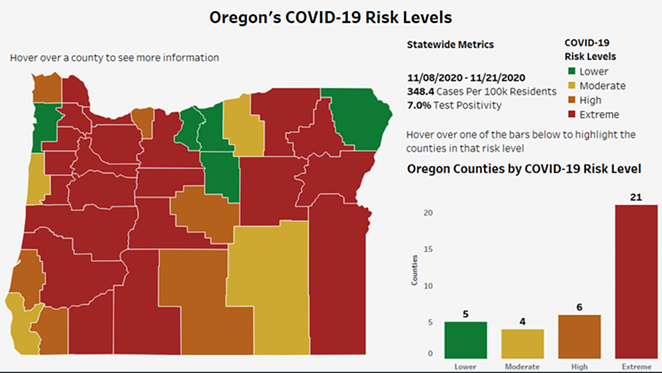One week ago, the Governor and state health officials imposed the freeze, which shut down in-person dining and shuttered gyms, among other restrictions, in an effort to slow the spread of COVID-19 in Oregon. Positive COVID-19 cases in the state have spiked throughout the month of November.
Under the new framework, counties can fall into one of four risk categories: lower, moderate, high and extreme risk. Twenty-one counties fall into the extreme category—meaning they won't be reopening on the Dec. 2 target date set at the outset of the Two-Week Freeze, Brown said Wednesday. Six counties were deemed "high risk," including Prineville's Crook County.
"With infection rates surging in Oregon, the Governor also cautioned that strict health and safety measures will likely need to remain in place for at least 21 counties found to be at extreme risk for COVID-19 spread following the Two-Week Freeze, which ends on December 2," said a Wednesday statement from Brown's office. "The framework is intended to establish sustainable protection measures for Oregonians in counties with rapid spread of COVID-19, while balancing the economic needs of families and businesses in the absence of a federal aid package."
The Oregon Health Authority has a list of activities allowed under each risk category—though it's not yet clear what criteria OHA will use to determine each county's risk.
The Oregon Health Authority has a list of activities allowed under each risk category—though it's not yet clear what criteria OHA will use to determine each county's risk.
Starting Nov. 30, the Oregon Health Authority will analyze each county's data to determine risk categories.

Oregon Health Authority
County risk levels as of Nov. 25, according to Gov. Kate Brown's new health and safety framework.
"On Monday, November 30, the Oregon Health Authority will reexamine county data to determine which counties qualify for each risk level on December 3, following the end of the 2-Week Freeze. In each subsequent two-week period, the Oregon Health Authority will examine and publish county data weekly, but county risk levels will not change until the end of the second week. In the first week, counties will be given Warning Week data to prepare for potential risk level changes. In the second week, county risk levels will be updated based on that week’s data," the Governor's statement said.
Counties remaining in the "extreme risk" category will be subject to ongoing restrictions, including:
-Social and at-home gatherings with people from outside your household will be limited to a maximum of six people, with a recommended limit of two households.
-Restaurants, bars, and other eating and drinking establishments will be limited to a maximum of 50 people for outdoor dining only, with only six people per table. Takeout is strongly encouraged.
-Indoor recreation, fitness and entertainment establishments, including gyms, will remain closed, however, outdoor recreation, fitness, and entertainment activities, including outdoor gym activities, will be allowed, with a maximum limit of 50 people outdoors.
-Retail stores, grocery stores, pharmacies, and indoor and outdoor shopping centers and malls will be limited to a maximum of 50% of capacity, with curbside pick-up encouraged.
-Faith institutions, funeral homes, mortuaries, and cemeteries will be limited to a maximum of 25% of capacity or 100 people indoors (whichever is smaller), or 150 people outdoors.
-Office workplaces will be required to utilize remote work to the maximum extent possible, with public-facing offices closed to the public.
-Personal services businesses will be allowed to continue to operate with health and safety measures in place.
-Long-term care facilities can allow limited outdoor visitation, following established health and safety protocols.
In Bend, St. Charles Health System's CEO and President Joe Sluka pleaded with the community to limit gathering sizes over the Thanksgiving holiday, noting the limited supply of Intensive Care Unit beds in Oregon.
-Restaurants, bars, and other eating and drinking establishments will be limited to a maximum of 50 people for outdoor dining only, with only six people per table. Takeout is strongly encouraged.
-Indoor recreation, fitness and entertainment establishments, including gyms, will remain closed, however, outdoor recreation, fitness, and entertainment activities, including outdoor gym activities, will be allowed, with a maximum limit of 50 people outdoors.
-Retail stores, grocery stores, pharmacies, and indoor and outdoor shopping centers and malls will be limited to a maximum of 50% of capacity, with curbside pick-up encouraged.
-Faith institutions, funeral homes, mortuaries, and cemeteries will be limited to a maximum of 25% of capacity or 100 people indoors (whichever is smaller), or 150 people outdoors.
-Office workplaces will be required to utilize remote work to the maximum extent possible, with public-facing offices closed to the public.
-Personal services businesses will be allowed to continue to operate with health and safety measures in place.
-Long-term care facilities can allow limited outdoor visitation, following established health and safety protocols.
"During one of our St. Charles COVID-19 Incident Command calls last week, the dire situation we face became increasingly clear. On that day at that time, our Bend hospital was the only hospital in the state with any available ICU beds" -St. Charles President/CEO Joe Sluka
tweet this
In Bend, St. Charles Health System's CEO and President Joe Sluka pleaded with the community to limit gathering sizes over the Thanksgiving holiday, noting the limited supply of Intensive Care Unit beds in Oregon.
"During one of our St. Charles COVID-19 Incident Command calls last week, the dire situation we face became increasingly clear. On that day at that time, our Bend hospital was the only hospital in the state with any available ICU beds," Sluka wrote in an email Tuesday. "Suddenly, the refrain I’ve been hearing from colleagues throughout the nation hit incredibly close to home. Our health care workers can no longer be considered the front line of this fight. We are now your last resort."
Instead of gatherings, Sluka suggested people set up virtual meals to gather for the holiday—but ended his note with a ray of hope.
This story will be updated as needed.
Instead of gatherings, Sluka suggested people set up virtual meals to gather for the holiday—but ended his note with a ray of hope.
"Statewide, our hospitals are working on plans to distribute the first COVID-19 vaccines to health care workers and first responders in the coming weeks," he wrote. "We are starting to see the light at the end of this very long fight."
Patrick Allen, Director of the Oregon Health Authority, said at a press conference Wednesday that Oregon is expecting to begin vaccinating people against COVID-19 as early as the end of December, starting with health care workers who work closely with people with the virus. The first round of doses is expected to vaccinate 30,000 people—though with some 300,000 health care workers in the state, and with a federal plan for distribution still in the works, it's not yet clear how quickly the general public may see vaccines available, Allen said.
Patrick Allen, Director of the Oregon Health Authority, said at a press conference Wednesday that Oregon is expecting to begin vaccinating people against COVID-19 as early as the end of December, starting with health care workers who work closely with people with the virus. The first round of doses is expected to vaccinate 30,000 people—though with some 300,000 health care workers in the state, and with a federal plan for distribution still in the works, it's not yet clear how quickly the general public may see vaccines available, Allen said.
-Ashley Moreno contributed to this report.








